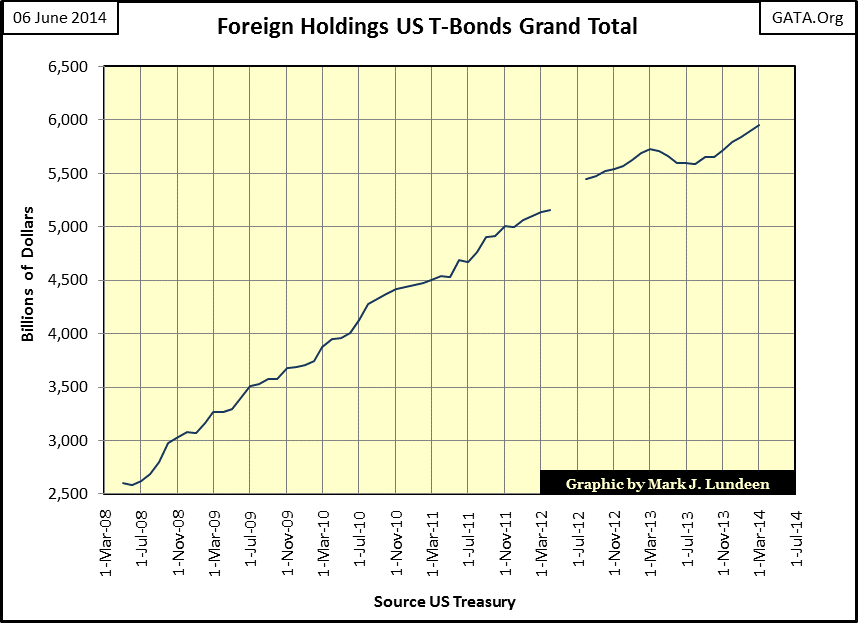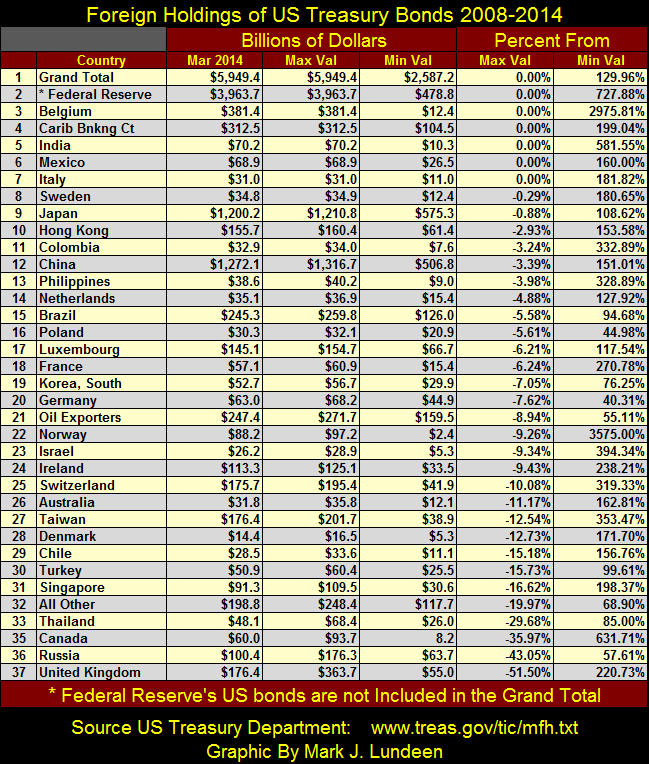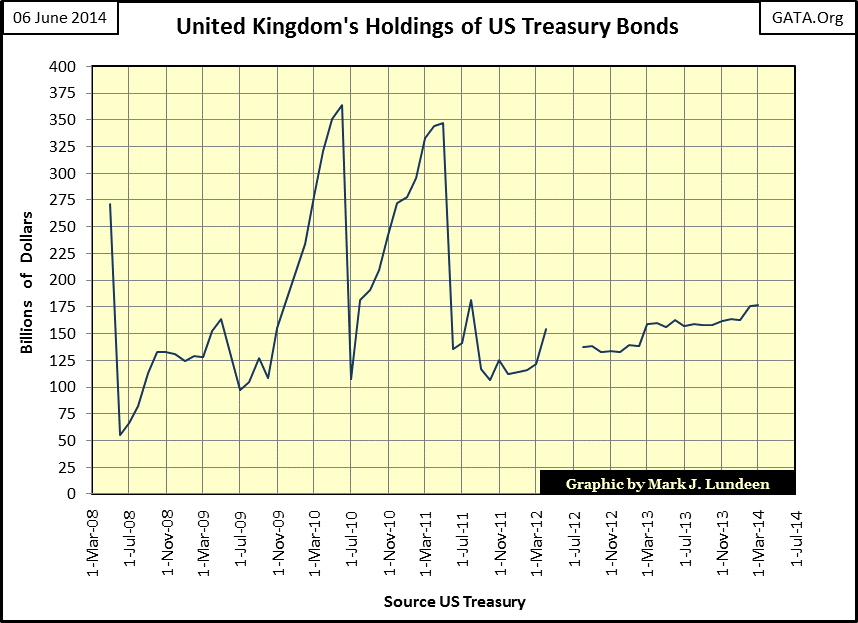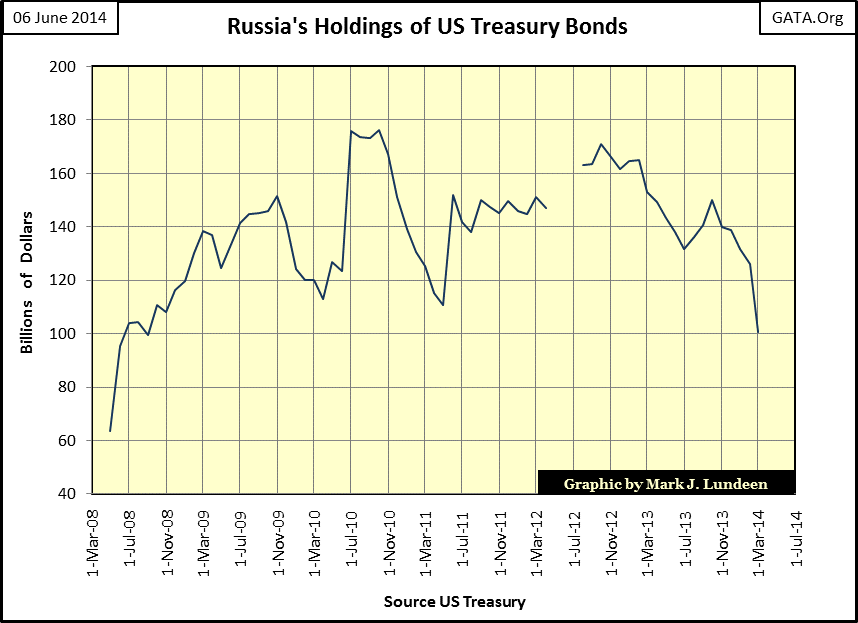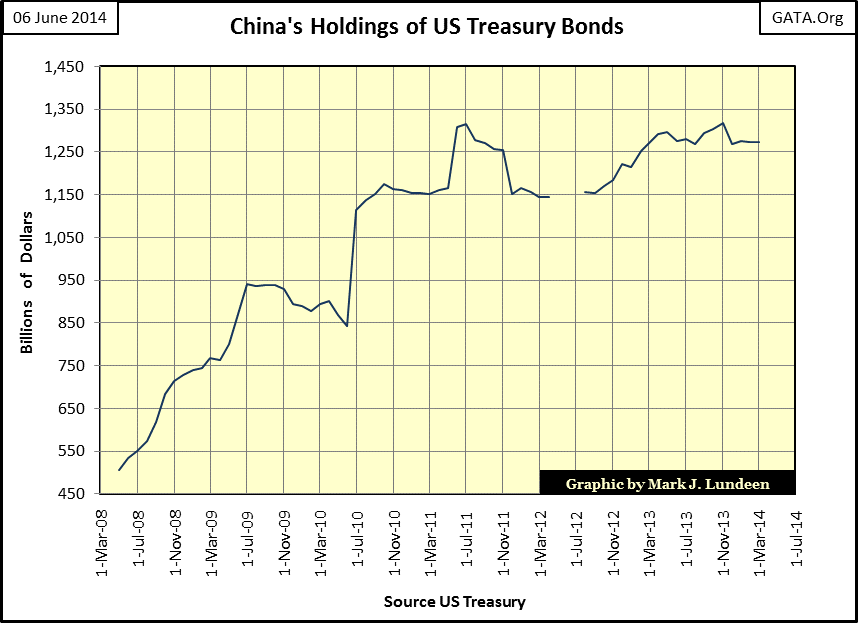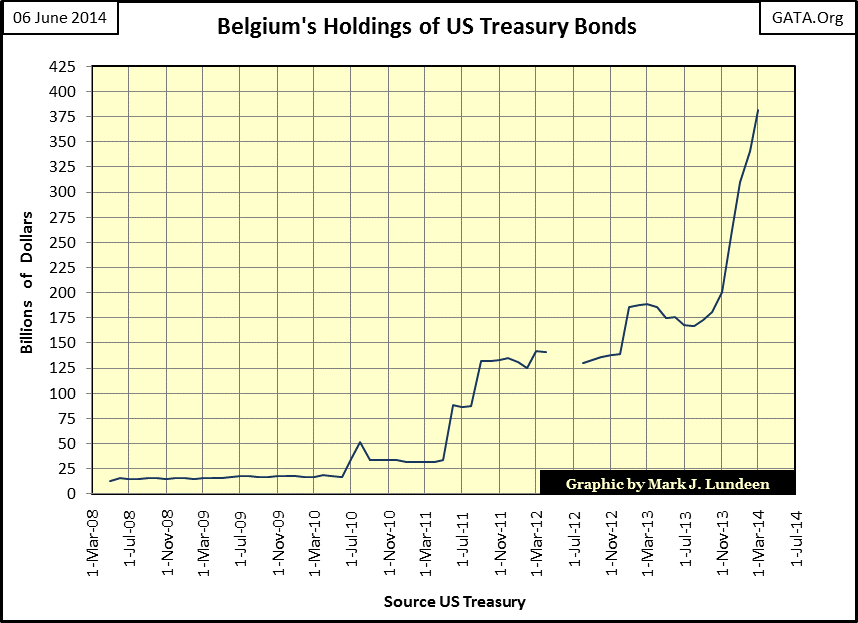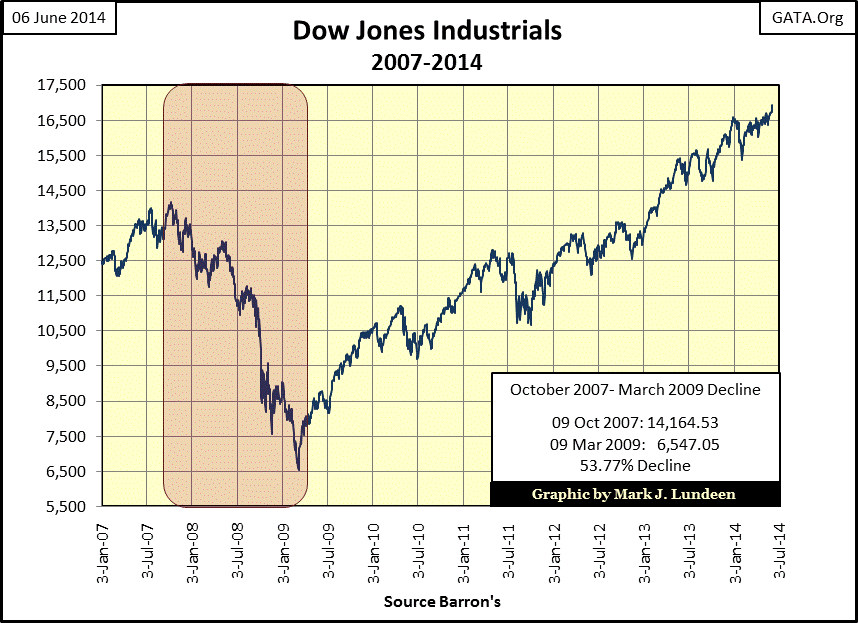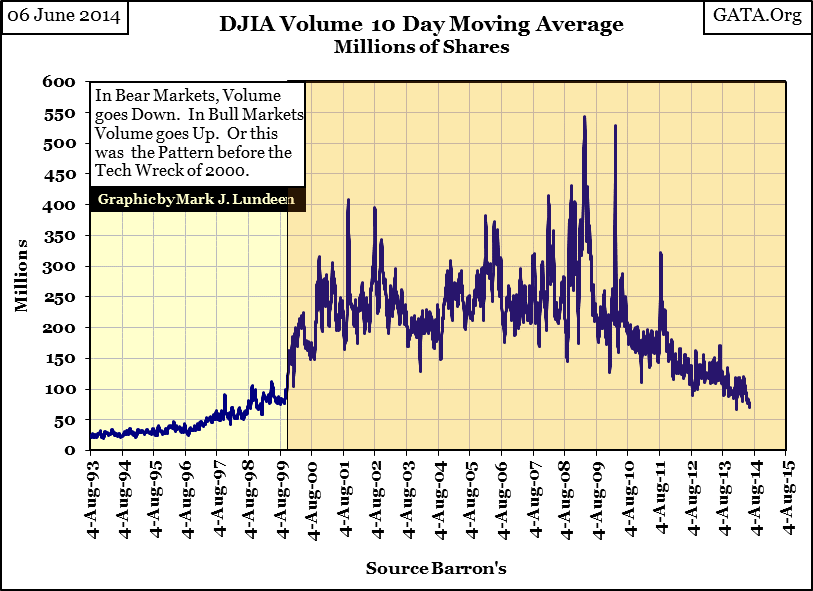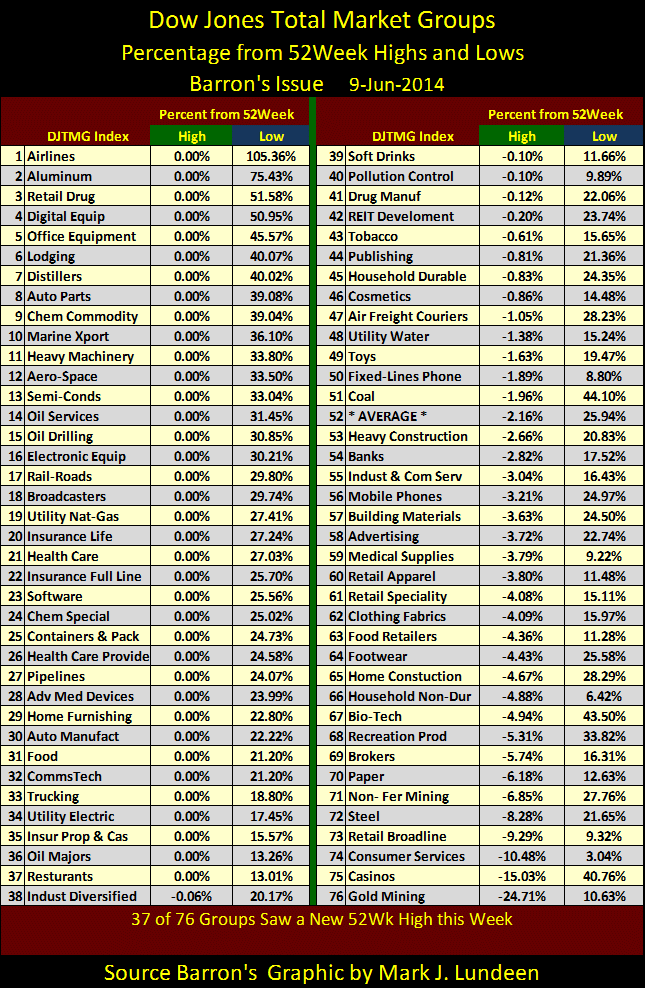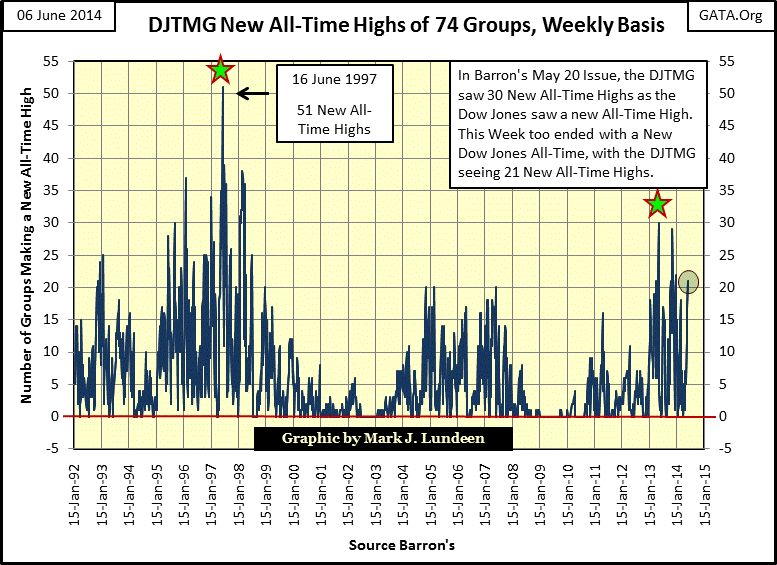US Treasury Bonds Held By Foreigners And A Look At The Stock Market
What a world we live in. The Ph.Ds. managing our financial markets have apparently discovered a means to bypass the law of supply and demand. Since January the Federal Reserve has tapered tens of billions of dollars from their monthly QE purchases and in response to this loss of demand, yields in the US Treasury market have dropped 50 basis points. Apparently this is what they want anyone who has noticed this anomaly to believe. It’s possible the decline in yields is a result of dumb foreigners taking up the Fed’s QE slack for lack of better investment opportunities elsewhere, but more likely the Federal Reserve, with its ethically-challenged banking system and their hedge-fund minions, are purchasing US T-bonds overseas using alias accounts.
Below is a chart plotting the data from the US Treasury showing total foreign holdings of US Treasury debt. Sorry for the gap in the plot. The Treasury only provides data for the past thirteen months; unfortunately in 2013 I updated the data sixteen months after my last update – hence the gap. Still the chart tells the story; since March 2008 the world has purchased an additional $3.3 trillion in US Treasury debt as of March 2014, the most recent data available. And from what I can tell from note #1 of the website below, these purchases are * NOT * by foreign central banks but private money.
http://www.treasury.gov/ticdata/Publish/mfh.txt
Look at this chart and think about it for a moment; where on earth did this $3.3 trillion dollars come from? Regular readers of my articles already know where; America’s engine-of-inflation – the Federal Reserve. If you really understood the implications of what you see below, you’d feel a bit of monetary nausea looking at it.
The table below lists the individual countries’ T-bond holdings given in the link above. The list is not all inclusive as since 2008 various countries have been added and removed from the list, so the table displays only those countries that have been continuously listed since 2008. I also included the Fed’s portfolio of T-bonds as it’s informative comparing our central bank’s T-bond purchases with the rest of the rest of the world since the 2008 mortgage debacle.
The table is sorted by “Percent From / Max Val” column (second from right). These percentages are calculated from the values seen to the left under the “Mar 2014” & “Max Val” columns. A 0.00% indicates a new all-time high in the holdings of US Treasury bonds for that country as of March 2014. A negative percentage indicates the percentage decline from its “Max Val” holdings. In the latest report there were five (six including the Fed) countries reaching a new all-time high in their US T-bond purchases, and twelve countries with a double digit reduction in their holdings of US T-bonds.
Typically the double-digit declines occurred over many months, or even years ago as was the case for the United Kingdom as seen below. Keep in mind this data isn’t for the Bank of England but private money. As London is a major player in the international financial markets, we can assume much of the wealth seen in this chart belongs to people who are not subjects of the Queen. It’s interesting to note that since 2008 the UK’s holdings of US T-bonds was reduced by more than $200 billion in just a few months - three times - without causing a calamity in the global financial markets.
I frequently see comments that Russia’s reaction to the Obama administration’s involvement in the Ukrainian situation might be to sell its US Treasury bonds in retaliation, and the chart below gives some credence to that. But based on the US Treasury’s data used in this article, Russians could liquidate their entire portfolio of T-bonds and not cause much of a problem for Washington, or the bond market. As noted above, since 2008 the UK has reduced its holdings of US T-bonds by $200 billion three times with little effect on the bond market.
However I have no data on how many T-bonds Russia’s central bank owns, maybe enough to cause serious problems for Wall Street. If they could I doubt Putin currently would want to take the spotlight off the historic domestic and international blunders the Obama administration’s “community organizers” are becoming famous for.
Here’s the chart for China’s US T-bond holdings. Other than the US Federal Reserve, the Chinese own more US Treasury debt than anyone else, and for all the concerns of China liquidating their portfolio of Uncle Sam’s IOUs, as of last March they hadn’t even started yet. But since 2008 they have increased their holdings of US T-bonds by just under a trillion dollars, and if they are currently having buyer’s remorse over these purchases I’d understand.
There’s a school of thought that should China liquidate all of their US Treasury debt, it would result in an unmitigated crisis in the financial markets. But what these people choose to ignore is that tiny, little Belgium, the socialist heartland of Europe, is always there to come to Washington’s rescue – or so it would seem in the chart below.
What’s strange about this huge accumulation of T-bonds by Belgium is that they couldn’t possibly have this much money and if they do, why doesn’t the dark heart of the European Union invest their money in something European? That’s what Germany, Europe’s economic powerhouse, seems to be doing (#20 in table above). The most likely answer is that these recent purchases of T-bonds are by foreigners, like JP Morgan and Goldman Sachs acting as agents for the US Treasury using inflationary funding provided by the Federal Reserve. It’s a huge stretch of the imagination to believe that natural demand for US T-bonds in tiny, little Belgium increased by a few hundred billion dollars at the same moment that the Federal Reserve began their tapering of QE.
Today, Friday June 6th, the Dow Jones made its eighth new all-time high for 2014 taking the Dow up 483 points for the year, or up 2.94% in the past five months.
This isn’t exactly a roaring bull market, and it’s not just the miniscule gains so far this year in the Dow Jones that lets us know that. Back in 1999 even Grandma was watching CNBC as the Dow Jones went on from one new all-time high to the next. Fifteen years later bull-market fatigue has become firmly established. I suspect most people aren’t aware the Dow made a new record high today for the simple reason they’ve moved on and no longer care. I don’t think a similar market weariness has ever happened before: a growing national indifference to making a killing in a rising stock market; but that is apparently what’s happening.
Look at the trading volume for the thirty blue-chip stocks in the Dow Jones; since 2009 it’s evaporated as the Dow moved from one all-time high to the next. If it wasn’t for high-frequency traders and companies’ going into the open market to buy back their own shares, would the Dow Jones companies’ trading volume even be ten million shares a day? This new paradigm smacks of manipulation. Up until the year 2000, the normal pattern was to see market valuations rise only on rising share volume. As you can see, this is no longer so.
Well I can bad mouth the Dow Jones and its vanishing volume all I want, but I can’t deny that there has been money made investing in the stock market over the past year as we can see in the table below. But investors had to be in the right groups to have made the risks worthwhile, which wasn’t hard as 51 of the 76 groups ended the week at least 20% above their 52Wk lows. Look at aluminum (#2) up 75% from its 52Wk Lows and even coal (#51) an object of hated by the environmental movement, and the bully boys at the EPA, is 44% off its lows of the year.
For the most part I stopped recommending the precious metal miners (dead last at #76) a few years back as there are powerful people in high places who are just dead set against seeing any excitement in the old monetary metals, including their miners. But there comes a time when a monetary and debt crisis will devastate the stock and bond markets. Tens of trillions of dollars, euros, yen and you name it are going to exit financial assets for fear of counterparty risk, and their owners will then begin to think about investing in gold and silver. But they are going to discover that most of the gold and silver has already been shipped to Asia, and is never coming back to the West if investors have only paper money in exchange for it. That’s when the gold and silver miners become the darlings of Wall Street; but we are not there just yet. If you want to sell high, you first have to buy low. So take it from me, and the table above, the precious metal miners are now low.
Returning to the stock market, this week not only ended with the Dow Jones at a new all-time high, but with 21 indexes in the Dow Jones Total Market Group (DJTMG) also ending the week at new all-time highs.
In May 2013 (star to the right) we saw the DJTMG end the week with 30 indexes at all-time highs, something not seen since the high-tech bubble. During the years of the housing bubble the DJTMG’s best effort at generating new all-time highs never exceeded 20. So far the “policy makers” have managed to exceed that extreme for seven weeks in this, their current stock market bubble. I wouldn’t be surprised if sometime before Christmas Janet Yellen doesn’t pump enough “liquidity” into the stock market to see 30 or even 40 groups at new all-time highs.
It’s a dangerous game she and her cohorts are playing. They have let it be known that taking a bearish position in the financial markets will be punished, so the entire investing universe is now long in the stock market. In the coming days of reckoning the market will be going down with no bids offered by the short sellers as Doctor Bernanke and now Janet Yellen have driven them away. Future double-digit percentage down days of the sort seen in October – November 1929 should be anticipated, but exactly when this will happen I can’t say as I don’t know.







